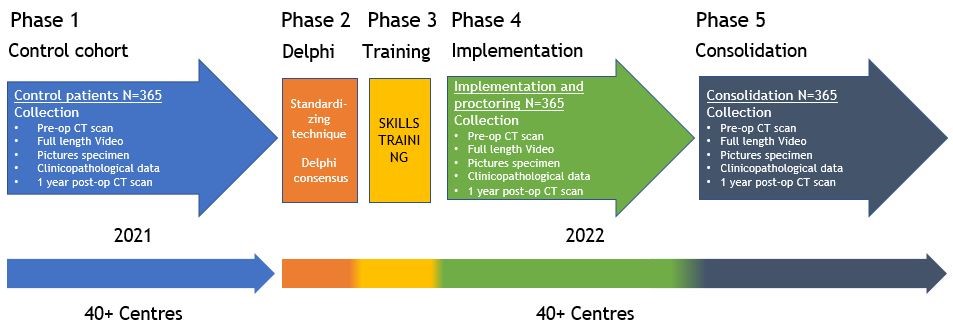Colorectal cancer is the third most common cancer in the world. For about 40% of colorectal cancer patients, the cancer is located on the right side of the colon. The standard treatment is removal of this part of the colon, or right hemicolectomy, usually along with associated lymph nodes due to potential metastases. This is a common operation that is performed in almost all hospitals in the Netherlands.
Internationally, there has recently been increased attention for optimizing right hemicolectomy for colon carcinoma. This procedure is now routinely performed with keyhole surgery (laparoscopically or robotically). This has improved recovery after surgery. Despite this, the complication rate is still relatively high and there is room for improvement in terms of cancer recurrence and survival.
Surgical variation
Surveys have found that surgical procedures can be highly variable amongst surgeons and different centers. This is in part due to the evolution of surgical techniques over the last decade and anatomical complexity.
“From our experience with the courses we give to trainee surgeons, there appears to be an enormous variety in performing this operation between hospitals in the Netherlands, and even between surgeons within one hospital,” said Alexander Grüter. “Although variation in practice is not necessarily bad, it is undesirable when it does not conform to the most recent insights.”
Towards consensus on the preferred method
Because clinical outcomes are associated by the quality of the surgery, a detailed objective assessment of the right hemicolectomy procedure is greatly needed to standardize this operation. A consensus on the best method will improve surgical training and allow implementation of the latest knowledge to improve care for patients with right-sided colon cancer.
To achieve this aim, researchers at Cancer Center Amsterdam are conducting “The Right Study”. During this project, with input from all participating hospitals, it will be determined what the most optimal surgical procedure is to perform a laparoscopic or robot-assisted right hemicolectomy and then implement this standardized operation in the Netherlands.

The Right Study: methods
The Right Study consists of 5 phases (see figure below):
- phase 1: the inventory phase,
- phase 2: the Delphi phase,
- phase 3: the training phase,
- phase 4: the implementation phase, and
- phase 5: the consolidation phase.
Phase 1 of the study is currently underway. This part is focused on evaluating the current variation in surgical practice at 44 different Dutch centers. The most optimal and standardized surgical technique will be determined in phase 2. In phase 3, the standardized technique will be taught to the surgeons of the participating centers, and in phase 4 & 5 this standardized technique will be implemented, first with proctoring (phase 4) and later without proctoring (phase 5). These methods are carefully followed to safely implement the best surgical technique for laparoscopic and robot-assisted right hemicolectomy in the Netherlands.

For more information contact: Alexander Grüter, MSc.

